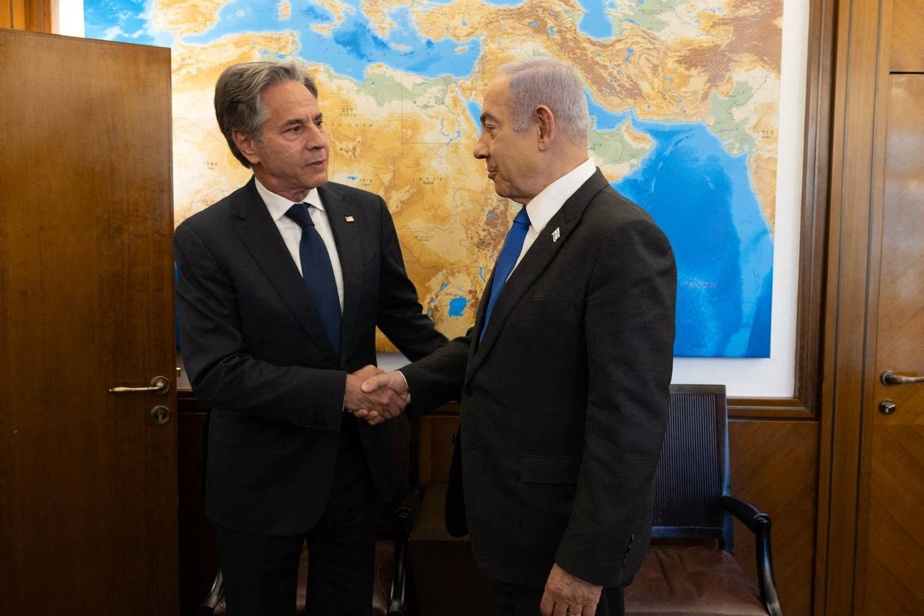US Secretary of State Antony Blinken met Prime Minister Benjamin Netanyahu in Israel on Monday, during a new tour to defend a ceasefire plan in the Gaza Strip after more than eight months of war with Hamas.
This eighth regional tour by the Secretary of State since the start of the war in the Palestinian territory aims to advance a truce proposal announced on May 31 by US President Joe Biden.
While Hamas has not officially reacted to this proposal, the United States clearly places the primary responsibility for accepting it on the Islamist movement.
After a stop in Cairo and a meeting with the Egyptian President, Abdel Fattah al-Sissi, the head of American diplomacy met Benjamin Netanyahu for approximately two hours in Jerusalem.
Mr. Blinken stressed that “the proposal on the table would pave the way for calm along Israel’s northern border” with Lebanon and “further integration” of Israel “with countries in the region,” according to the State Department.
The text, which “welcomes” the truce proposal announced on May 31 by US President Joe Biden and calls on Israel and Hamas “to fully implement its terms without delay and without conditions”, received 14 votes in favor, with Russia saying abstaining.
In Cairo, Blinken called on regional countries to “pressure Hamas” to agree to a ceasefire.
“I firmly believe that the overwhelming majority” of Israelis and Palestinians “want to believe in a future” in which both peoples “live in peace and security,” he added.
At a time when dissension is growing within the coalition in power in Israel, the release of four hostages has reinforced Mr. Netanyahu in his military strategy against Hamas, which carried out a bloody attack on Israeli soil on October 7.
Mr. Netanyahu, for his part, maintains his objective of eliminating Hamas, in power in the Gaza Strip since 2007 and considered a terrorist organization by Israel, the United States and the European Union.
On Saturday, an Israeli special forces operation enabled the release of four hostages, a woman and three men, in Nousseirat, in the center of the besieged territory.
Hamas’ health ministry said 274 people were killed and 698 injured, denouncing a “massacre” in a densely populated area. This assessment could not be independently verified.
The mother of Almog Meir Jan, one of the freed hostages, called on the government on Monday to reach a deal to free the other hostages.
“The remaining hostages need a deal to return home safely,” Orit Meir said, asking the Israeli government “to move forward with the deal on the table.”
The war in the Gaza Strip was sparked on October 7 by an unprecedented attack by Hamas in southern Israel, which resulted in the deaths of 1,194 people, mostly civilians, according to an AFP tally established from official Israeli data.
Of 251 people kidnapped, 116 are still held hostage in Gaza, of whom 41 are dead, according to the Israeli army.
In response, the Israeli army launched an offensive on the Gaza Strip, which left at least 37,124 dead, mostly civilians, including at least 40 in 24 hours, according to data from the Gaza government’s Health Ministry. Gaza ruled by Hamas.
On Monday, an Israeli strike on a house in Gaza City, in the north of the territory, left five people dead, including an eight-month pregnant woman, according to Civil Defense.
Also in the north, a strike killed two people in a house in Choujaiya, according to al-Ahli hospital.
In the center, the air force carried out a strike on Deir al-Balah, while artillery fire was heard east of this city, causing deaths according to witnesses.
The army announced that it was engaged in an operation in the east of Deir al-Balah and the east of the nearby Bureij camp.
“Soldiers are conducting ground and underground operations against terrorist infrastructure and locations used to fire rockets toward Israel,” the army said.
In the south, witnesses reported fighting in central Rafah, a town where the army launched a ground offensive against Hamas on May 7.
This offensive pushed a million Palestinians to flee and led to the closure of the Rafah border crossing with Egypt, crucial for the entry of international aid into the territory hit by a humanitarian disaster.
The UN World Food Program also suspended the delivery of aid from an American floating jetty on Monday in order to assess the security situation.
After months of unsuccessful efforts by the mediating countries, Qatar, Egypt and the United States, to reach a ceasefire, the United States presented a text to the Security Council calling for support for the latest road map.
This plan, “accepted” by Israel according to the latest version of the American text, provides, in a first phase, a six-week ceasefire accompanied by an Israeli withdrawal from densely populated areas of Gaza, the release of certain Palestinian hostages and prisoners held by Israel.




